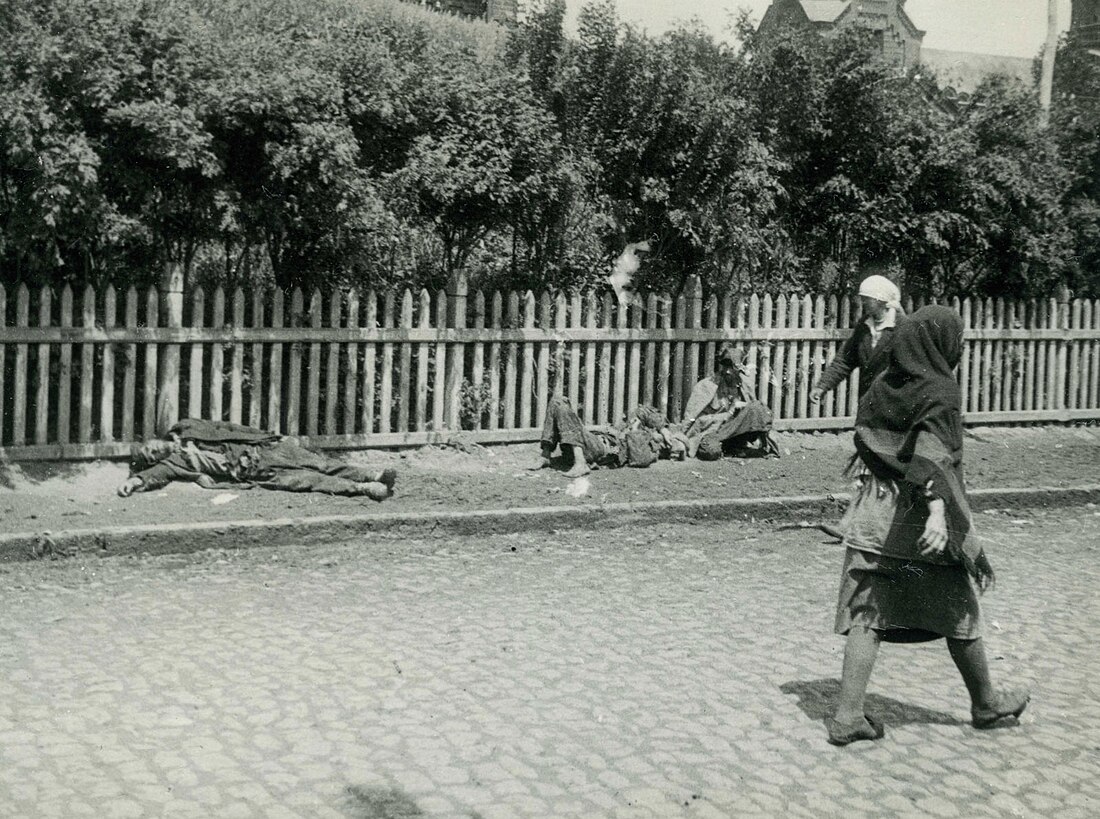Holodomor
man-made famine in Soviet Ukraine in 1932–33 that killed as many as seven million Ukrainians From Wikipedia, the free encyclopedia
Remove ads
The Holodomor[a] was a man-made famine[2] that happened in Ukraine in 1932 and in 1933. It is also known as the Terror-Famine or Great Famine. Ukraine was part of the Soviet Union back then. Around 7,000,000 people died under the policies of Joseph Stalin.[2][3]
Remove ads
History
Joseph Stalin was the leader and dictator of the Soviet Union, which was a communist country. He made farmers in the Soviet Union change the way they farmed; then he tried to make the farmers work harder for the government-owned farms, for less money.[4] Many people in Ukraine did not want to go along with this.
When Ukraine had a famine, Stalin refused to help the people there. Instead, the government took food away from people. It became illegal (against the law) to pick up food from the ground of fields.[5] The government also tried to stop people from moving around the country to look for food.

Remove ads
Legacy
Scholars and politicians using Holodomor say the famine was a genocide because it was man-made.[6] Some compare it to the Holocaust because millions of people died.[6] They argue that the Soviet policies were an attack on the rise of Ukrainian nationalism and therefore is a genocide.[7][8]

Officially recognized as an act of genocide
Officially condemned as an act of extermination
Officially not recognized as an act of genocide

Other scholars say that the Holodomor was an unexpected consequence of the rapid and massive industrialization started by Stalin, which brought radical economic changes to the farmers and the country, and which was not done on purpose.[8][9]
Remove ads
Denial
Soviet Union
The Soviet Union's regime is said to have denied the Holodomor throughout its existence.[10] It is also said to have never commemorated the Holocaust.
| “ | The Soviet system never commemorated the Holocaust. One reason for this is that once you define and identify one genocide, you can recognize other genocidal crimes. The Soviet empire didn’t want us to learn our history. Decades of Soviet education and censorship ensured that even after the USSR collapsed, many in Lviv[b] failed to realise the striking proximity of the Holocaust. | ” |
—Victoria Amelina[11] | ||
Communist Party USA
News of the Holodomor reached the US in 1933.[12] The Yiddish Jewish Daily Forward was one of the media that reported the Holodomor.[12] Shortly after, it was accused by the Soviet-funded[13] Communist Party USA (CPUSA) of "spreading Nazi-inspired lies",[12] despite the magazine being run by Jewish Americans.[12]
Walter Duranty
Walter Duranty, a Moscow-based New York Times journalist in the 1930s, wrote a series of articles denying the Holodomor and praising Joseph Stalin, while millions of Ukrainians starved to death. The articles ironically won Duranty the 1932 Pulitzer Prize, which caused controversies in the following decades. In 2003, the New York Times and Pulitzer Prize board reviewed Duranty's articles separately, yet declined to withdraw his prize.[14][15]
Oksana Piaseckyj, a Ukrainian-American activist who fled to the United States as a child in 1950, referred to Walter Duranty as "the personification of evil in journalism."[16] This case has become the biggest scandal in the history of the New York Times.[17]
Responses
Ukraine
Ukraine passed the Law On the Holodomor of 1932-1933 in Ukraine in 2006 to ban Holodomor denial, recognizing it as an insult to the memory of victims and humiliation of the dignity of Ukrainians.[18]
Germany
In November 2022, Germany recognized the Holodomor as a genocide,[19] while changing a law to ban the approval, denial, and "gross trivialization" of genocides or war crimes in the new paragraph 5 of section 130 of the German Penal Code, the Strafgesetzbuch.[20][21]
Remove ads
Gallery
- Passers-by ignore corpses of starved peasants on a street in Kharkiv, Ukraine, 1933.
- Children are digging up frozen potatoes in the field of a collective farm in Udachne village, Donetsk Oblast, Ukraine, 1933.
- Chicago's American front page depicting Holodomor's starvation to death of six million Ukrainians.
- Daily Express pictures on Holodomor genocide by forced starvation of six million Ukrainian peasants.
- Photo by Thomas Walker in Chicago American, reporting people eating cats and dogs to survive in Soviet Ukraine, 1935.
- "1933. 15th anniversary. 8.000.000 victims of hunger in Ukraine". A postcard printed in Germany by Ukrainian Youth Association for the 15th anniversary of Holodomor.
- Stamp of Ukraine of the year 1993.
- Memorial at the Andrushivka village cemetery, Vinnytsia Oblast, Ukraine.
- Memorial in Poltava Oblast, Ukraine.
Remove ads
Recognition
Remove ads
Related pages
Footnotes
References
Wikiwand - on
Seamless Wikipedia browsing. On steroids.
Remove ads













